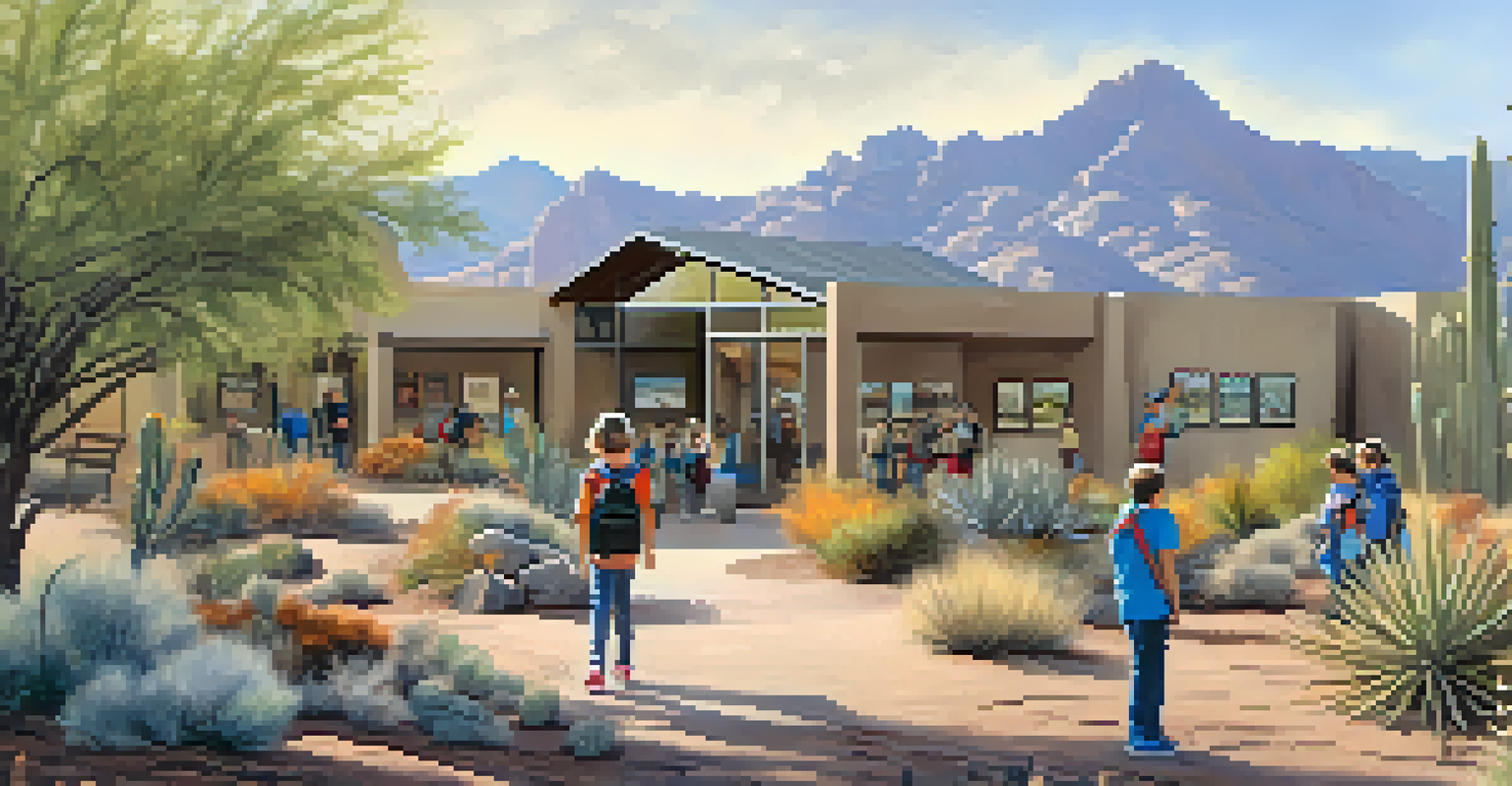Exploring the Rich Biodiversity of Tucson's Wildlife Sanctuaries

Introduction to Tucson's Unique Biodiversity
Tucson, Arizona, is a hidden gem when it comes to biodiversity. Nestled in the Sonoran Desert, it’s home to a stunning variety of wildlife, from majestic birds to elusive mammals. The region's unique climate and geography create the perfect environment for diverse ecosystems that thrive in harmony.
In every walk with nature one receives far more than he seeks.
Wildlife sanctuaries in Tucson play a crucial role in protecting this rich biodiversity. These areas serve as safe havens for countless species, ensuring their survival amidst urban development and environmental changes. By visiting these sanctuaries, you not only witness the beauty of nature but also support conservation efforts.
Exploring these sanctuaries can feel like stepping into a different world. With each visit, you’ll encounter new sights, sounds, and experiences that deepen your appreciation for the natural world. So, let’s dive into some of Tucson’s most remarkable wildlife sanctuaries and discover what makes them so special.
The Role of the Arizona-Sonora Desert Museum
The Arizona-Sonora Desert Museum is more than just a museum; it’s a living showcase of the Sonoran Desert’s wildlife. This 98-acre facility combines a zoo, botanical garden, and natural history museum, offering visitors a comprehensive view of the desert's unique ecosystems. Walking through its trails, you can see everything from native plants to local animals in their natural habitats.

One of the highlights of the museum is its commitment to education and conservation. Through various programs and exhibits, visitors learn about the importance of preserving wildlife and the challenges they face. This hands-on approach fosters a deeper understanding of the interconnectedness of life in the desert.
Explore Tucson's Wildlife Sanctuaries
Tucson's wildlife sanctuaries offer diverse ecosystems that are vital for wildlife conservation and provide unique experiences for visitors.
The museum also emphasizes the role of local species in the ecosystem. For instance, you’ll find exhibits dedicated to the significance of pollinators like bees and bats, which are crucial for plant reproduction. This focus on education helps inspire a sense of responsibility for protecting Tucson’s rich biodiversity.
Exploring the Sweetwater Wetlands
Sweetwater Wetlands is a stunning oasis located just outside Tucson, offering a unique glimpse into wetland ecosystems. This sanctuary is a birdwatcher’s paradise, attracting migratory birds and local species alike. As you stroll along the trails, you might spot everything from herons to ducks, making it an ideal spot for both casual observers and avid birders.
The Earth has music for those who listen.
The wetlands play a vital role in filtering water and providing habitat for various wildlife. They serve as a natural purification system, helping to maintain the health of the surrounding environment. This ecological function highlights the importance of wetlands in supporting biodiversity and combating climate change.
Visiting Sweetwater Wetlands is not just about birdwatching; it’s also an opportunity to connect with nature. The serene atmosphere, combined with the symphony of wildlife sounds, creates a peaceful retreat from the hustle and bustle of everyday life. It’s a reminder of the beauty and tranquility that nature has to offer.
The Significance of the Cienega Creek Preserve
Cienega Creek Preserve is a remarkable sanctuary that showcases the importance of riparian habitats. This area is characterized by lush vegetation and a flowing creek, making it a vital resource for both wildlife and humans. The preserve is home to numerous species, including endangered ones, which rely on this unique ecosystem for survival.
The preserve’s diverse habitats support a variety of wildlife, from insects and amphibians to mammals and birds. The presence of water attracts species that might otherwise be absent in the arid desert. Observing the interactions within this ecosystem can provide a fascinating insight into the delicate balance of life.
Arizona-Sonora Desert Museum's Role
The Arizona-Sonora Desert Museum serves as an educational hub, showcasing the importance of local species and conservation efforts.
Cienega Creek Preserve also offers recreational opportunities for visitors. Hiking trails wind through the area, allowing for exploration and appreciation of the natural beauty. Whether you’re a nature enthusiast or just looking for a peaceful escape, this preserve offers a unique experience that highlights the wonders of Tucson’s biodiversity.
Understanding the Importance of Conservation
Conservation is a critical aspect of protecting Tucson's wildlife sanctuaries. With urban expansion and climate change posing threats to these ecosystems, proactive measures are essential. By prioritizing conservation efforts, we can ensure that future generations will also have the opportunity to experience the beauty of Tucson’s diverse wildlife.
Many sanctuaries engage in restoration projects to rehabilitate degraded habitats. These initiatives often involve replanting native species, controlling invasive plants, and creating safe spaces for wildlife. Such efforts not only improve the health of the ecosystems but also enhance the overall visitor experience.
Community involvement is vital for successful conservation. Local organizations and volunteers often play a key role in maintaining sanctuaries and educating the public. By participating in these efforts, individuals can contribute to the ongoing preservation of Tucson’s unique biodiversity.
Wildlife Spotting Tips for Visitors
When visiting Tucson’s wildlife sanctuaries, having a few wildlife spotting tips can enhance your experience. First, consider visiting during the early morning or late afternoon when animals are most active. The cooler temperatures during these times make for great opportunities to see wildlife in action.
Bringing binoculars or a camera with a zoom lens can significantly improve your chances of spotting animals from a distance. Many species are shy and may prefer to observe you rather than be seen. Patience is key; sometimes, it’s just a matter of waiting quietly and watching for movement.
Conservation is Key for Biodiversity
Active conservation efforts and community involvement are essential for protecting Tucson's unique biodiversity amid urban development.
Lastly, familiarize yourself with the local wildlife before your visit. Knowing what species to look for can make your experience more engaging and educational. Whether it’s recognizing the call of a bird or spotting tracks on the ground, being informed can deepen your connection to Tucson’s wildlife.
Conclusion: Embracing Tucson's Natural Heritage
Tucson's wildlife sanctuaries offer a remarkable opportunity to connect with nature and appreciate the region's rich biodiversity. From the Arizona-Sonora Desert Museum to the tranquil Sweetwater Wetlands, each sanctuary provides unique experiences that highlight the beauty of the natural world. These spaces are not only vital for wildlife but also for our well-being as humans.
As we explore these sanctuaries, it’s essential to remember our role in protecting them. Supporting conservation efforts and being mindful of our impact can help ensure that these ecosystems thrive for years to come. Every small action contributes to the larger goal of preserving Tucson’s natural heritage.

So, whether you’re a local or a visitor, consider spending a day in one of Tucson’s wildlife sanctuaries. You’ll not only gain a deeper understanding of the unique ecosystems but also foster a greater appreciation for the diverse wildlife that calls Tucson home.